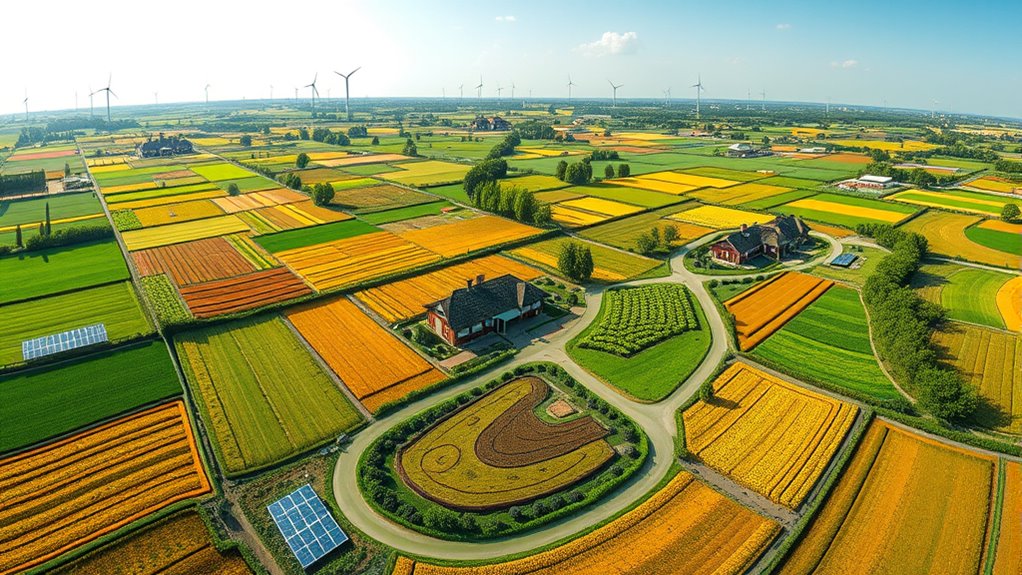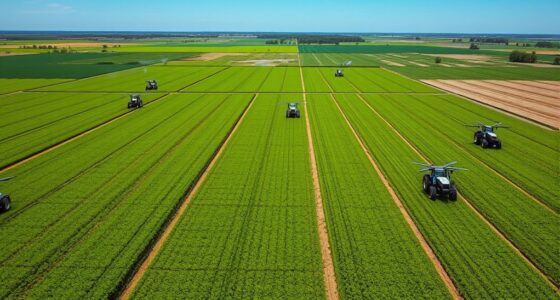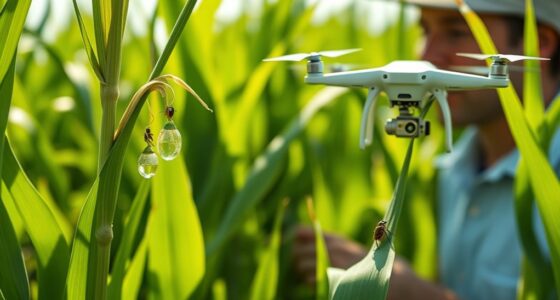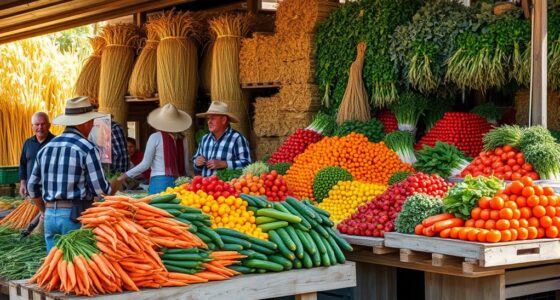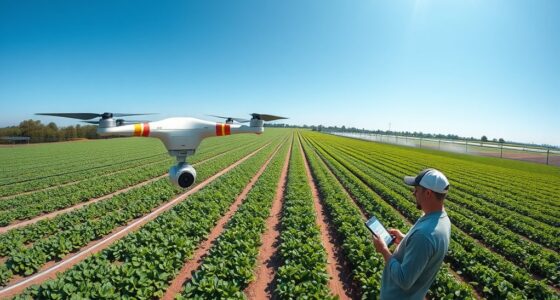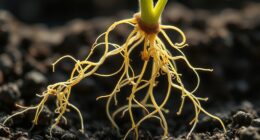By 2025, sustainable agriculture is transforming through digital innovations like drone mapping and real-time data, which help optimize resource use and boost yields. Farmers are adopting climate-smart practices such as crop diversification and soil health methods to build resilience. Supply chains are becoming more transparent with blockchain, and policy support is growing worldwide to encourage eco-friendly methods. Stay with us to explore how these trends are shaping the future of farming and food security.
Key Takeaways
- Increased adoption of digital technologies like drone mapping and real-time data analytics to optimize resource use and improve farm sustainability.
- Expansion of climate-smart practices such as crop diversification, soil health management, and water efficiency to boost resilience.
- Growing integration of blockchain and certification standards to enhance transparency, traceability, and responsible sourcing.
- Policy incentives, subsidies, and international cooperation driving investment in regenerative and eco-friendly agricultural methods.
- Rising consumer demand for sustainable, organic, and health-focused products influencing global farming practices.
Innovations in Precision Farming and Digital Technologies

Innovations in precision farming and digital technologies are transforming how you manage your fields, making agriculture more efficient and sustainable. Drone mapping allows you to quickly survey large areas, capturing high-resolution images that reveal soil health, pest issues, and crop conditions. This real-time data helps you make informed decisions, reducing waste and optimizing inputs like water and fertilizers. Crop monitoring with digital tools enables you to track plant growth, identify stress signs, and detect diseases early. By integrating these technologies into your routine, you gain a clearer picture of your farm’s health and productivity. These advancements not only increase yields but also promote sustainable practices, conserving resources and minimizing environmental impact. Incorporating digital innovation into your operations can further enhance your ability to adapt to changing conditions and optimize resource use. Portable farming equipment innovations are enhancing operational flexibility and efficiency across diverse terrains. Digital innovations are revolutionizing farming, making it smarter and more eco-friendly, with precision tuning techniques supporting tailored management strategies.
Adoption of Regenerative Agricultural Practices
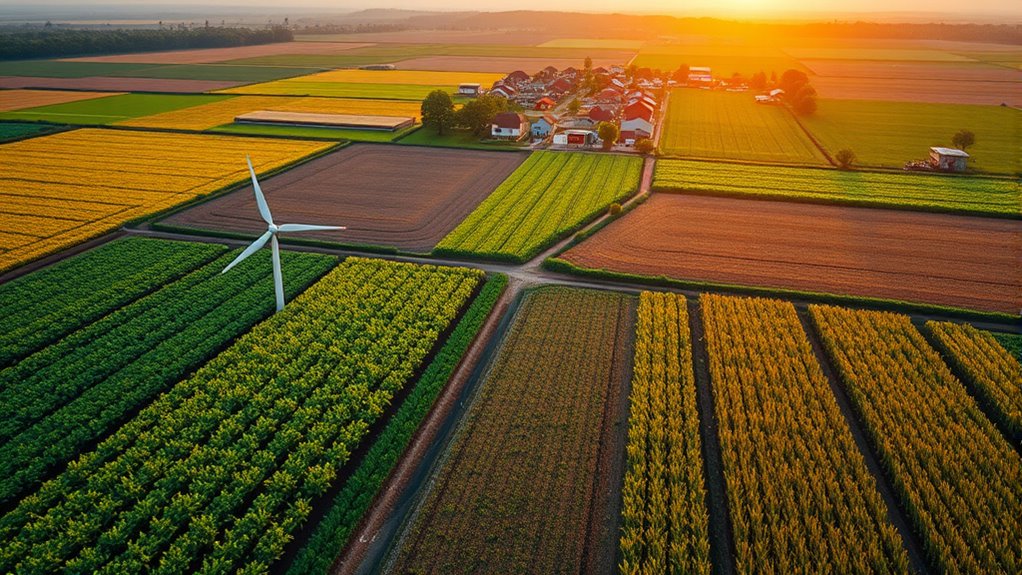
Building on the advances in precision farming and digital tools, many farmers are now turning their attention to regenerative agricultural practices to further enhance sustainability. You’re likely adopting methods that prioritize soil conservation, such as cover cropping and reduced tillage, which help restore soil health and prevent erosion. Crop diversification also plays a key role, allowing you to grow a variety of crops that improve ecosystem resilience and reduce dependency on single crops. These practices not only boost long-term productivity but also sequester carbon and improve water retention. Implementing secure payment systems can facilitate seamless transactions for farm inputs and sales, further supporting sustainable operations. Additionally, integrating soil health monitoring technologies enables you to track improvements and make data-driven decisions. Using digital tools can help optimize resource use and enhance the efficiency of regenerative practices. As more farmers embrace regenerative techniques, you contribute to healthier soils and more sustainable farming systems. The shift signals a proactive move toward balancing productivity with environmental stewardship.
Expansion of Sustainable Supply Chains and Certification Programs

As consumers increasingly demand transparency and ethically sourced products, farmers and supply chain stakeholders are expanding sustainable supply chains and certification programs. You’ll notice more companies adopting practices that emphasize supply chain transparency, making it easier for you to trace product origins. Certification standards are becoming stricter, ensuring that products meet environmental and social criteria. This shift encourages responsible sourcing and boosts consumer confidence. Additionally, the integration of blockchain technology is revolutionizing traceability, providing real-time data on supply chain steps and enhancing accountability. You might see:
- Increased use of blockchain for traceability, providing real-time data on supply chain steps
- Broader adoption of certifications like Fair Trade and Organic, aligning with consumer values
- Greater collaboration among stakeholders to meet evolving certification standards
- The adoption of best practices such as toilet maintenance and repairs to ensure long-term sustainability in agricultural infrastructure. Implementing quality assurance measures further supports these initiatives by maintaining high standards throughout the supply chain.
Integration of Climate-Smart Agriculture Strategies

With supply chains becoming more transparent and certification standards tightening, integrating climate-smart agriculture strategies helps you adapt to changing environmental conditions while maintaining productivity. These strategies boost your climate resilience by reducing vulnerability to extreme weather events and shifting rainfall patterns. Crop diversification plays a crucial role here, spreading risk and improving overall farm stability. Implementing practices like improved water management, precision farming, and integrated pest management enhances both resilience and sustainability. Consider the following benefits of climate-smart strategies: | Benefit | Explanation | |——————————|————————————————| | Increased climate resilience | Better withstands climate-related shocks | | Enhanced crop diversification | Reduces dependency on single crops | | Higher productivity | Maintains yields despite climate stress | | Sustainable resource use | Conserves water and soil health | Adaptive management approaches can further optimize these strategies by continuously responding to changing environmental conditions, which is vital for long-term sustainability. Incorporating climate adaptation techniques ensures that agricultural practices remain effective amid evolving climate patterns.
Growing Emphasis on Soil Health and Biodiversity
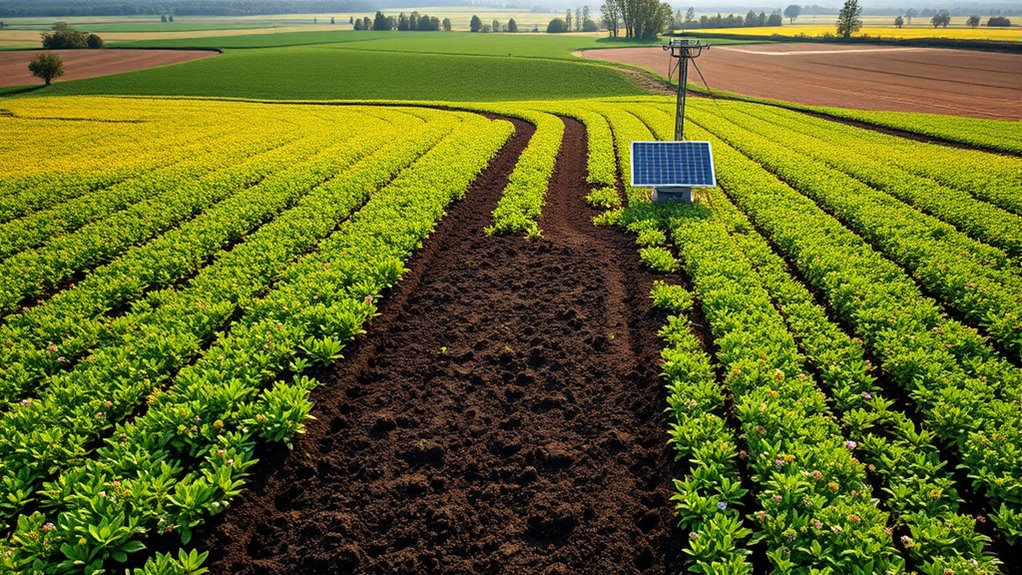
Why is there a growing focus on soil health and biodiversity in sustainable agriculture? Because healthy soils support resilient crops and eco-friendly practices. You’ll find that improving the soil microbiome boosts plant growth naturally, reducing reliance on chemicals. soil microbiome plays a crucial role in nutrient availability and disease suppression. Plus, farmers are protecting biodiversity hotspots—areas rich in diverse species—that safeguard ecosystems and promote resilience. To do this, they adopt cover cropping, reduced tillage, and organic amendments. These practices nurture beneficial microorganisms, enhance nutrient cycling, and restore natural habitats. Recognizing the importance of asset division in land management can help farmers plan for sustainable use and transfer of resources. Additionally, integrating remote collaboration tools allows agricultural experts to share best practices and innovations across regions more efficiently. You’ll notice a shift toward practices that emphasize soil significance, recognizing its critical role in long-term productivity. Ultimately, prioritizing soil health and biodiversity not only sustains yields but also preserves ecosystems for future generations.
Policy Initiatives and Global Cooperation for Sustainable Development
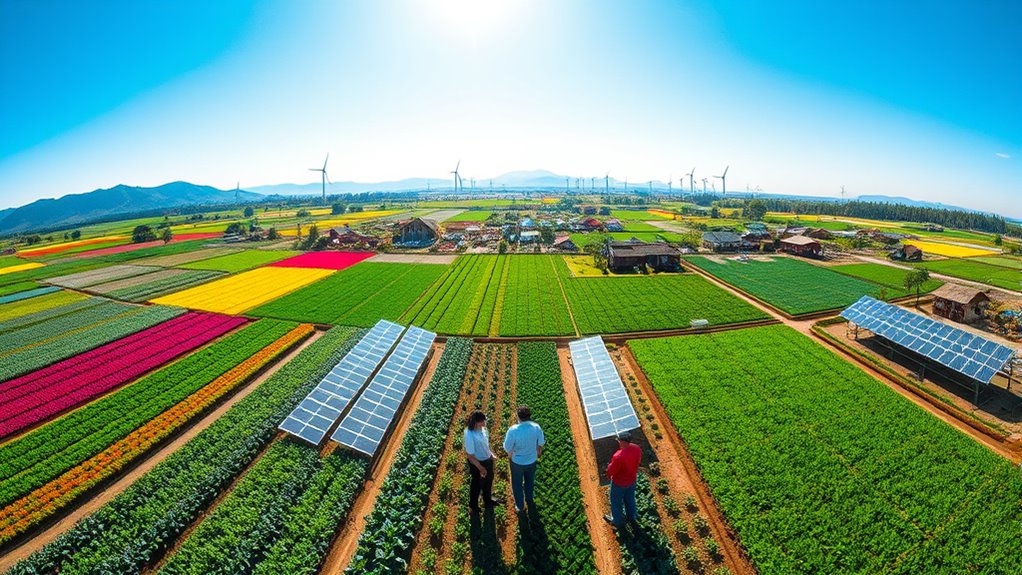
Policy initiatives and global cooperation play a pivotal role in advancing sustainable agriculture by aligning national strategies and fostering international partnerships. Cross-border collaboration enables countries to share knowledge, technology, and resources, accelerating progress toward sustainability goals. Policy incentives, such as subsidies and tax breaks, motivate farmers and businesses to adopt eco-friendly practices. These incentives create a supportive environment for innovation and investment in sustainable solutions. By working together, nations can address common challenges like climate change, water scarcity, and biodiversity loss more effectively. International frameworks and agreements set standards, encouraging consistency and accountability. Promoting juice cleansing as a health trend demonstrates how consumer habits can influence agricultural practices and sustainability efforts. Strengthening international cooperation ensures that efforts are more comprehensive and effective across borders. Supporting policies that promote sustainable practices and incentivize sustainable practices can lead to tangible improvements on the ground and foster a more resilient agricultural sector.
Frequently Asked Questions
How Will Sustainable Agriculture Impact Global Food Prices by 2025?
You might notice that sustainable agriculture can lead to more market stability by promoting consistent practices and reducing reliance on volatile inputs. As a result, food prices could become less prone to sudden swings, helping you better plan your budget. While initial costs may rise, in the long run, sustainable methods aim to lower price volatility, making global food prices more predictable and accessible for everyone.
What Role Do Smallholder Farmers Play in Achieving These Trends?
You see smallholder farmers as essential contributors to sustainable agriculture, empowering them through access to resources, training, and technology. Their local knowledge fuels innovative practices, preserves biodiversity, and adapts solutions to specific environments. By fostering farmer empowerment, you help build resilient communities, enhance food security, and promote eco-friendly farming. Smallholders become the stewards of change, transforming local landscapes into models of sustainability and inspiring global progress toward a greener future.
How Will Technology Accessibility Vary Across Different Regions?
You’ll find that technology accessibility varies widely across regions due to the digital divide and infrastructure gaps. In developed areas, you’ll have better internet and advanced tools, making adoption easier. Conversely, in underserved regions, limited infrastructure restricts access, slowing progress. Addressing these disparities requires targeted investments and innovative solutions to bridge the digital divide, ensuring all farmers can benefit from sustainable agricultural technologies and contribute to global sustainability goals.
What Are the Main Challenges in Implementing These Practices Globally?
You face several challenges when implementing sustainable practices globally. Policy barriers often hinder progress by limiting incentives or creating complex regulations, while resource limitations, like water, land, and finances, restrict adoption, especially in developing regions. Overcoming these obstacles requires coordinated efforts to reform policies, improve resource access, and support farmers with education and technology. Addressing these issues is vital for widespread sustainable agriculture adoption.
How Can Consumer Behavior Influence Sustainable Agriculture Adoption?
Did you know that 73% of consumers say they’ve changed their purchasing habits based on sustainability? Your consumer awareness and purchasing power can considerably influence sustainable agriculture adoption. When you choose eco-friendly products, you encourage farmers to adopt better practices. Your demand for sustainable options drives companies to prioritize environmentally friendly methods, ultimately leading to broader adoption. Your choices matter, so support sustainable agriculture to create a greener future.
Conclusion
As you embrace these global trends, you’ll find sustainable agriculture transforming like a rising tide, lifting communities and ecosystems alike. Innovation, policy, and collaboration act as the wind in its sails, guiding us toward a greener future. By adopting regenerative practices and harnessing digital tools, you become part of a movement that nurtures the earth’s vigor. Together, we can cultivate a more resilient and bountiful world—one harvest at a time.
